Final Report for GNE14-073
Project Information
Planted as a result of bad weather, emergency annual forage crop mixtures can be more productive than monocultures, use resources more efficiently, and reduce the risk of a subsequent crop failure. A warm-season forage crop mixture experiment was conducted across the Northeastern United States with four trials in 2013 and five trials in 2014 with four crop species selected based on differences in stature and nitrogen acquisition traits: 1) pearl millet (Pennisetum glaucum L.); 2) sorghum sudangrass (Sorghum bicolor L. Moench x S. sudanense P.); 3) cowpea (Vigna unguiculata L.); and 4) sunn hemp (Crotolaria juncea L.). Crops were seeded in monoculture and in three- and four- species mixtures using a replacement design where monoculture seeding rates were divided by the number of crops in the mixture. In 2013, crop biomass was sampled at approximately 45 and 90 days after planting (DAP) and in 2014 samples were also taken at 35 DAP. When averaged across the 9 site-years, the first sampling ranged from 280 lbs acre-1 (cowpea) to 680 lbs acre-1 (pearl millet-sorghum sudangrass-cowpea); second sampling ranged from 930 lbs acre-1 (cowpea) to 2,700 lbs acre-1 (pearl millet); third sampling ranged from 1,780 lbs acre-1 (cowpea) to 7,020 lbs acre-1 (pearl millet-sorghum sudangrass-sunn hemp). Weed biomass was negatively correlated with crop biomass.
Acid detergent fiber (ADF), neutral detergent fiber (NDF), and crude protein (CP) were assessed for all plots, and preliminary forage quality data are reported here. When averaged across the 9 site-years, ADF was at 25% or less for all cropping treatments in the first sampling date, but increased to almost 50% for sunn hemp by the final sampling date. Between the first two sampling dates, NDF increased by about 10% for all cropping treatments, but increased at a slower rate between the second and third sampling dates. Grasses had lower CP than legumes, but the amount didn’t change between the first and second sampling, however, it did decrease by the third sampling date.
Overall, biomass production of the legume monocultures was lower than the grass monocultures and mixtures at all sampling dates. Weed biomass tended to decrease with increasing crop biomass. Forage quality decreased over time with grass monocultures and sunn hemp becoming the least digestible annual species at the end of the season.
Introduction:
An unfavorable winter climate impairs perennial forage stands, corn silage does not establish because of unforeseen pest problems, a drought-ridden summer stalls crop growth are all familiar situations which lead to the decision to plant annual forages known for their place in crises as “emergency forages” (Kramer & Johnson, 2007). When integrated crop-livestock farmers are at risk for losing their crops, for whatever reason, they often embrace the practice of planting summer annual forages. These forages can be planted in monoculture or the already at-risk farmer can choose to plant a mixture of annual forage crops and gain benefits of diversity as a way to mitigate the risk of another potential crop failure.
As climate change continues to affect agriculture, these possibilities of crop failure become greater, particularly in more contrived agroecosystems that have a greater dependence on synthetic inputs. The 2014 National Climate Assessment predicts a 71% increase of heavy precipitation events in the Northeast (Walsh et al., 2014). Therefore, we suggest that annual forage crop mixtures should not be grown only in emergencies, but rather they should be integrated in crop rotations as a routine practice. This increased spatial and temporal diversification will better imitate natural systems in their ecological complexity and function. As part of a systems approach to ecological intensification, annual forage crop mixtures can reduce risk, increase cropping system resilience, and help close yield gaps by enhancing ecosystem services (Lin et al. 2008). In addition to enhancing productivity by providing yield limiting ecosystem services (i.e. ecological enhancement), diverse annual forage crop mixtures can increase resource use efficiency and decrease the need for external inputs (i.e. ecological replacement) (Bommarco et al. 2013).
This research project used four summer annual forage crops consisting of two grasses and two legumes: (i) pearl millet [Pennisetum glaucum (L.) R. Br.], (ii) sorghum sudangrass [Sorghum bicolor (L.) Moench × S. sudanense (Piper) Stapf], (iii) cowpea [Vigna unguiculata (L.) Walp], and (iv) sunn hemp (Crotalaria juncea L.). We selected these drought tolerant crops because they differed in stature and nitrogen acquisition traits and because they could be grown together as a short-season forage crop or as a cover crop.
Pearl millet is a deep-rooted, tillering cereal crop that grows rapidly and performs well in poor soil, high heat, and drought conditions (Lee et al. 2012, Newman et al. 2010). It matures relatively early with approximately 50% of plants reaching reproductive maturity approximately 60 days after planting (Jefferson Institute 2002). Farmers in the Northeastern US currently grow pearl millet as a forage crop. Pearl millet can also be used as a cover crop and has been shown to suppress soil-borne diseases, root-lesion nematodes, and increase soil organic matter (Ball-Coelho et al. 2001, Newman et al. 2010, Sheahan 2014).
Sorghum sudangrass is a cross between sorghum and sudangrass, and can grow taller than pearl millet. The brown-midrib varieties with reduced lignin content can match corn silage in terms of milk production (Ketterings et al. 2007, Kilcer et al. 2005, Miller and Stroup 2003, Tom Wright et al. 1998). Because of its more rapid growth and uniform ground cover, soil erosion potential with sorghum sudangrass is less than half of conventionally-tilled corn (Kilcer et al. 2005). Sorghum sudangrass is also commonly used as a summer cover crop and is known to secrete chemicals that suppress annual weeds and nematodes (Weston et al. 1989).
Cowpea is an herbaceous legume crop with a growth habit that ranges from vining to erect and bushy; it typically does not grow taller than 1 m (Davis et al. 1991). Cowpea is considered an important food crop in many arid subtropical regions. In the US, it is also known as black eyed peas, and is commonly grown as a grain and forage (McGiffen et al. 2012). Despite its ability to provide a cost effective source of high nitrogen forage in places such as the Southern Great Plains (Rao and Northup 2009), it is not as widely grown in more northern regions. In addition to fixing nitrogen and improving soil health, cowpea attracts beneficial insects because of additional nectar-release sites on petioles and leaflets (Rao and Northup 2009).
Sunn hemp is an herbaceous legume that can grow up to 3 m tall (SARE 2012). It is grown extensively as a green manure and can fix a large amount of nitrogen (FAO 2014). Sunn hemp is also used to suppress weeds and nematodes (Curto et al. 2015). In previous research in Alabama, sunn hemp was used as a winter cover crop and increased corn grain yield by 21% compared to fallow plots that did not have a cover crop (Balkcom and Reeves 2005). Riday and Albrecht (2008) successfully intercropped sunn hemp with corn in Wisconsin and found that it improved the forage quality of silage. If used for forage, the cultivar must have low alkaloid levels such as c.v. Tropic Sun, or else it could be toxic to cows (SARE 2012).
The treatments consisted of the species grown in monoculture, all possible three species mixtures, and the four species mixture. We used a replacement series design and seeded each species as a proportion of their recommended monoculture rate (i.e., in a three species mixture each species is seeded at one-third of their monoculture rate). We hypothesized that mixtures would outperform monocultures in terms of increased crop biomass, forage quality, and weed suppression.
The objectives are focused on assessing forage quality of the diverse mixtures and understanding how the change in species composition affects crop biomass, weed biomass, and forage quality at different times throughout the season. The objectives of the original proposal have changed due to some personal health problems that interrupted the research timeline. The objectives were revised and the budget was rewritten so that the grant funded the crude protein component of the forage quality analysis, rather than begin a new project as previously stated. For this reason, the objectives listed are the ones that remain relevant to the revised scope of the project.
Objectives:
- Conduct forage quality analysis on the diverse summer annual forages.
Acid detergent fiber (ADF), neutral detergent fiber (NDF), and crude protein (CP) was collected from an experiment containing treatments of the four species in monoculture, three species, and four species mixture in three different locations in the Northeast and mid-Atlantic area: Beltsville, MD; Aurora, NY; and Willsboro, NY for a total of nine site-years at two different sampling dates in 2013 and three sampling dates in 2014.
- Perform an economic analysis of the suggested practice and examine the potential for widespread adoption.
The cost of each cropping treatment and the production per cost of each cropping treatment was calculated. A full economic analysis with equipment and labor estimates, as well as estimated milk production per cropping treatment will be available in a forthcoming publication.
Cooperators
Research
In 2013, the Beltsville site included two trials with different planting dates: an early date in mid-June and a late date in mid-July. In 2014, the Aurora and Willsboro sites each included two trials again with differing planting dates: an early planting date in mid-June and a later planting date in mid-July after winter wheat (Triticum aestivum L.) was harvested (Table 1).
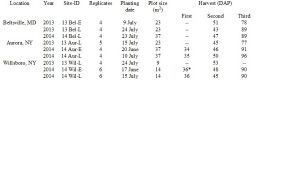 Table 1. Planting and sampling dates for years and field sites. The “E” stands for early and “L” stands for late Site-ID names relate to whether the crop was planted before (E) or after (L) a winter small grain crop would be harvested.
Table 1. Planting and sampling dates for years and field sites. The “E” stands for early and “L” stands for late Site-ID names relate to whether the crop was planted before (E) or after (L) a winter small grain crop would be harvested.
Experimental Design
A randomized complete block design with four to six replications was used to compare four monoculture treatments and five intercrop treatments representing all combinations of three- and four-species mixtures. A complete randomized design was used at the 13-Bel-L site-year because of logistical challenges. The four warm-season annual crops tested in monoculture and mixtures were obtained from King’s Agriseed and include: pearl millet ‘Wonderleaf’, sorghum sudangrass ‘AS6401’, cowpea ‘Iron Clay’, and sunn hemp ‘VNS’.
Intercropped seeding rates were based on a replacement series design such that each species included in an intercrop was seeded at the recommended monoculture rate divided by the number of species in the intercrop (Table 2). Pearl millet had the lowest seeding rate weight because of its relatively small seed size. Pearl millet, sunn hemp, and cowpea had germination rates of 80% and sorghum sudangrass had a germination rate of 85% according to the seed label (King’s Agriseeds, 2013). To ensure consistent targeted emergence rates among species, seeding rates were on a live-seed basis to compensate for differences in germination rates of each species.
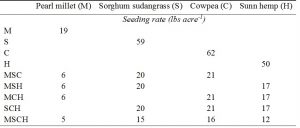 Table 2. Target crop seeding rates used in the four monoculture and five intercrop treatments.
Table 2. Target crop seeding rates used in the four monoculture and five intercrop treatments.
Field Operations
Fields were chisel plowed, disked, and cultipacked prior to planting the annual crops, but field preparation varied slightly across sites. Prior to planting, 35 kg ha−1 of total N was broadcast in the form of poultry litter (5–4–3); however, in the 13-Aur-L site-year, N was applied as mineral fertilizer (10–20–20 in the form of urea-diammonium phosphorous-muriate potash). Although this is more N than would typically be applied prior to legume crops, it represents less than half of the recommended rate for sorghum sudangrass (Ketterings et al., 2007). The legumes were inoculated with a rhizobium mixture suitable for cowpea and sunn hemp prior to planting. Crops were seeded to a depth of ~1.5 in using a 1590 drill (John Deere) at Aurora and Beltsville and a Great Plains drill (Great Plains) at Willsboro in 7.5 in rows.
Sampling
The first biomass samples were collected at 34 to 36 days after planting (DAP), the second biomass samples were collected at 43 to 53 (DAP), and the third biomass samples were collected prior to seed maturation at 77 to 90 DAP (Table 1). Plants were clipped 10 cm above the soil surface, separated by crop species, dried at 60°C for up to 1 week, and then weighed.
Forage Quality
Samples were assessed for forage equality on a dry matter basis. Samples were sealed into filtered bags and assessed using ANKOM200 using a 30-hour digestion. Acid detergent fiber provided an estimate of the least digestible forms of fibers (lignin, cellulose, and hemicellulose) to give an idea of the energy content. Neutral detergent fiber estimates predict the amount of fiber an animal is able to consume. Crude protein is estimated from the amount of the total nitrogen in the forage sample.
First to talk about the learning opportunity of the grant itself, it served to fund my research, but perhaps more importantly, it gave me invaluable insight into the grant-writing process that has since helped me earn other grants. The scope of the project changed quite a bit as an effect of unforeseeable circumstances but the main goal of the project—inform farmers about summer annual crop mixtures—remained the same.
In general, crop biomass increased as the growing season progressed (Figures 1-3). Legume monocultures produced less biomass than grass monocultures and mixtures at each sampling dates. Biomass of the mixtures was mostly from the grass species. Mixtures containing two grasses had less biomass at the first sampling but it was not a significant difference at later sampling dates. Grass monocultures and the mixtures produced relatively similar amounts of biomass. Across the nine site-years, mixtures had greater stability in their yields than monocultures. When averaged across the 9 site-years, the first sampling ranged from 280 lbs acre-1 (cowpea) to 680 lbs acre-1 (pearl millet-sorghum sudangrass-cowpea); second sampling ranged from 930 lbs acre-1 (cowpea) to 2,700 lbs acre-1 (pearl millet); third sampling ranged from 1,780 lbs acre-1 (cowpea) to 7,020 lbs acre-1 (pearl millet-sorghum sudangrass-sunn hemp).
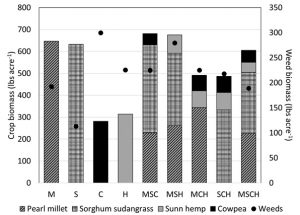 Figure 1. Crop and weed biomass by treatment for the first sampling (~35 DAP) across site-years. Weed biomass is plotted on a secondary axis, represented by circles for each treatment. M, pearl millet; S, sorghum sudangrass; C, cowpea; H, sunn hemp.
Figure 1. Crop and weed biomass by treatment for the first sampling (~35 DAP) across site-years. Weed biomass is plotted on a secondary axis, represented by circles for each treatment. M, pearl millet; S, sorghum sudangrass; C, cowpea; H, sunn hemp. 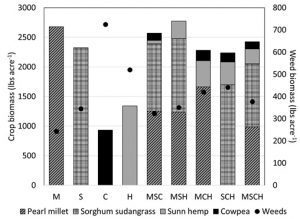 Figure 2. Crop and weed biomass by treatment for the second sampling (~45 DAP) across site-years. Weed biomass is plotted on a secondary axis, represented by circles for each treatment. M, pearl millet; S, sorghum sudangrass; C, cowpea; H, sunn hemp.
Figure 2. Crop and weed biomass by treatment for the second sampling (~45 DAP) across site-years. Weed biomass is plotted on a secondary axis, represented by circles for each treatment. M, pearl millet; S, sorghum sudangrass; C, cowpea; H, sunn hemp. 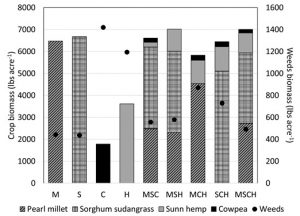 Figure 3. Crop and weed biomass by treatment for the third sampling (~90 DAP) across site-years. Weed biomass is plotted on a secondary axis, represented by circles for each treatment. M, pearl millet; S, sorghum sudangrass; C, cowpea; H, sunn hemp.
Figure 3. Crop and weed biomass by treatment for the third sampling (~90 DAP) across site-years. Weed biomass is plotted on a secondary axis, represented by circles for each treatment. M, pearl millet; S, sorghum sudangrass; C, cowpea; H, sunn hemp.
Forage quality decreased as the growing season progressed; the amount of ADF and NDF increased, while CP decreased (Figures 3-6). Grass monocultures and mixtures performed similarly, whereas legume monocultures contained higher amounts of crude protein. Sunn hemp, however, did decrease in digestibility over the course of the growing season, with values that resembled the grasses and an ADF percentage at the third sampling above the other cropping treatments. When averaged across the 9 site-years, the first sampling ranged from 13% (cowpea) to 25% (pearl millet-sorghum sudangrass-cowpea) for ADF; 22% (cowpea) to 52% (pearl millet-sorghum sudangrass-cowpea) for NDF; and, 21% (pearl millet-sorghum sudangrass-cowpea) to 28% (sunn hemp) for CP. The second sampling ranged from 22% (cowpea) to 34% (pearl millet) for ADF; 31% (cowpea) to 63% (pearl millet) for NDF; and, 21% (pearl millet-sorghum sudangrass-cowpea) to 28% (sunn hemp) for CP. The third sampling ranged from 30% (cowpea) to 47% (sunn hemp) for ADF; 40% (cowpea) to 67% (pearl millet) for NDF; and, 8% (sorghum sudangrass) to 14% (cowpea) for CP.
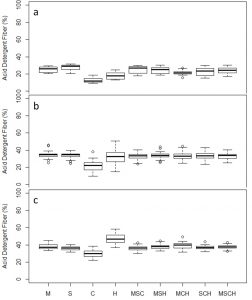 Figure 4. Acid detergent fiber results of the first, second, and third sampling date (a, b, and c, respectively). M, pearl millet; S, sorghum sudangrass; C, cowpea; H, sunn hemp.
Figure 4. Acid detergent fiber results of the first, second, and third sampling date (a, b, and c, respectively). M, pearl millet; S, sorghum sudangrass; C, cowpea; H, sunn hemp. 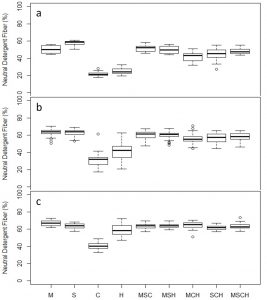 Figure 5. Neutral detergent fiber results of the first, second, and third sampling date (a, b, and c, respectively). M, pearl millet; S, sorghum sudangrass; C, cowpea; H, sunn hemp.
Figure 5. Neutral detergent fiber results of the first, second, and third sampling date (a, b, and c, respectively). M, pearl millet; S, sorghum sudangrass; C, cowpea; H, sunn hemp. 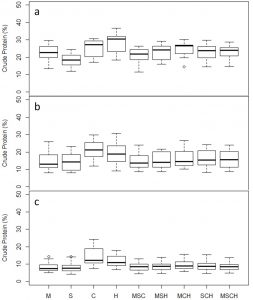 Figure 6. Crude protein results of the first, second, and third sampling date (a, b, and c, respectively). M, pearl millet; S, sorghum sudangrass; C, cowpea; H, sunn hemp.
Figure 6. Crude protein results of the first, second, and third sampling date (a, b, and c, respectively). M, pearl millet; S, sorghum sudangrass; C, cowpea; H, sunn hemp.
Crop biomass was a more important factor than diversity for suppressing weeds (Figures 1-3). If weed suppression is the top priority for the summer annual crop, these results suggest that monocultures of high biomass-producing grasses will provide more effective suppression at a lower seed cost than functionally diverse mixtures that include low biomass-producing legumes in warm-season mixtures. Despite the weak weed suppression from the two legumes compared to the two grasses, legume crops can provide other benefits including increased forage quality, soil nitrogen for subsequent crops, and resources for pollinators if allowed to flower.
This research was important for understanding how a summer annual crop changes over a growing season so that a farmer can best manage the crop for their needs. If the intention is to maximize the amount forage production, then the farmer could harvest at ~90 DAP and supplement for necessary nutrients. Harvesting earlier in the season would produce less biomass but a higher quality. Pearl millet and sorghum sudangrass have better forage regrowth potential and could be managed for multiple cuts.
Research in summer annual crops is useful for increasing the sustainability of cropping systems. These forages can be used as “emergency forages” or integrated into perennial cropping systems during the summer when the typical cool season crop growth rate slows, thus it has the potential to increase forage productivity for farmers and reduce their reliance on off-farm inputs (like imported feed). The information this grant generated will serve to inform farmers, extension workers, seed salespeople, and crop consultants of crop production and forage quality potential of various combination of these four species. Hopefully, availability of this research will provide farmers with the information they deem necessary when considering to plant summer annual forage crops.
Education & Outreach Activities and Participation Summary
Participation Summary:
There were several journal articles, conference presentations, and farmer outreach functions related to this project. Journal articles include Functional Diversity in Summer Annual Grass and Legume Intercrops in the Northeastern United States was published in Crop Science in 2016 by myself, advisor Matthew Ryan, and a collaborator at the USDA Steven Mirsky. Weed Suppression in Functionally Diverse Grass and Legume Cover Crop Mixtures is another manuscript in review for Weeds Science by the same authors. Results from the forage quality analyses that this grant funded are currently being prepared for another manuscript.
The first journal article was selected by the Agronomy, Crop Science, and the Soil Science Societies of America (ASA, CSSA & SSSA, respectively) for a general-education publication: https://www.agronomy.org/science-news/intercropping-intersection-soil-health-production, which led to a whole host of farm journals, magazines, radio shows, and newspapers to write about the topic (see links at end).
Intercropping -Intersection of soil health production, American Society of Agronomy (pdf)
In addition to this, there were several talks and posters at the annual conference of the following societies: Cornell University School of Integrated Plant Science, ASA, CSSA, and SSSA, Weed Science Society, and Northeastern Weed Science Society. One of which is my Master’s seminar that is available on Youtube (link below).
Bybee-Finley, K. A., Mirsky, S., Ryan, M. (2016, November). Assessing competition in warm season grass-legume intercrops using partial land equivalent ratios across nine site-years. Paper presented at the ASA, CSSA & SSSA International Annual Meeting, Phoenix, AZ.
Bybee-Finley, K. A., Mirsky, S., Ryan, M. (2016, November). Weed Suppression in Warm Season Grass-Legume Intercrops. Poster presented at the ASA, CSSA & SSSA International Annual Meeting, Phoenix, AZ.
Bybee-Finley, K. A. (2016, October). Building Resilience in Northeastern Forage Production. Lightning Talk at the School of Integrated Plant Sciences Symposium, Ithaca, NY.
Bybee-Finley, K. A., Mirsky, S., Ryan, M. (2016, January). Weed Suppression in Grass-Legume Summer Annual Forage Intercrops. Paper presented at the Northeastern Weed Science Society Annual Meeting, Philadelphia, PA.
Bybee-Finley, K.A. (2014, November) Low-input Intercropping of Summer Annual Crops in the Northeast. Presentation at the Crop and Soil Sciences Department Seminar at Cornell University, Ithaca, NY. A video of this presentation is available at https://www.youtube.com/watch?v=vfeuHkhPcZ4.
Bybee-Finley, K. A., Mirsky, S., Ryan, M. (2014, February). Niche Management with Polycultures of Summer Annual Forage Crops. Poster presented at the Weed Science Society of America Annual Meeting, Vancouver, BC.
Bybee-Finley, K. A. (2014, January). Comparison of Weed Suppression in Monocultures and Grass-Legume Mixtures of Summer Annual Forages. Paper presented at the Northeastern Weed Science Society Annual Meeting, Philadelphia, PA.
Bybee-Finley, K. A. (2013, November). Grass-Legume Mixtures in Low-Input Summer Annual Forage Crop Production. Paper presented at the ASA, CSSA & SSSA International Annual Meeting, Tampa, FL.
I also gave extension-focused talks at Northeastern Organic Dairy & Field Crop Conference, NOFA, and the Musgrave Research Farm Field Day. I have attended and participated in some NIFA conferences as well. In general, most of my outreach has been toward an academic audience. At the extension talks, the audiences were generally engaged and each had about 20 people in attendance. Most farmers who implement grazing practices seemed to be interested in how annual intercrops could fit into their grazing rotation and extending their grazing season with summer annual forages, which I think is a very relevant question and one I hope to address in the Agronomy Journal publication, but not one I entirely understood at the beginning of the project (new to agriculture). I hope that I as I move ahead with my research, I can better contextualize the results and deliver them in a more meaningful way to farmers.
Bybee-Finley, K. A., Benson, F. A. (January 21, 2017). Ensuring your farm has forage in a changing climate Presentation at the Northeast Organic Farming Association NY Annual Conference, Saratoga, NY.
Bybee-Finley, K. A. (2014, July). Summer Annual Forage Mixtures Experiment. Presentation of my fieldwork at the Aurora Field Day at Musgrave Research Farm, Aurora, NY.
Bybee-Finley, K. A., Liebert, J., Ryan, M. (2014, March). Innovative Cropping Systems. Presentation at the3rd Annual Northeastern Organic Dairy & Field Crop Conference, Auburn, NY.
http://www.newsreality.com/post/intercropping-intersection-of-soil-health-production.html
http://ravallirepublic.com/business/agriculture/article_63aabfd6-a911-57ee-9775-c4b9bafacf35.html
http://www.producer.com/2016/12/foraging-ahead-with-intercropping/
Project Outcomes
Of all the cropping treatments, pearl millet monoculture was the least expensive, while the legumes monocultures were the most expensive (Table 3). As biomass production increased between the sampling dates, the amount of biomass per dollar seed cost increased (Table 4). The production per dollar increased by a greater rate for the grasses than the legumes. The SCH intercrop was the most expensive mixture. Since the seed costs for the legumes could be cost prohibitive, using more commonly used legumes, like red clover, might be a better option than the ones used here, but would have a difficult time competing during with the other species studied here. The MSH had the greatest production per dollar. Although we did not test two species mixtures, a grass mixture of pearl millet and sorghum sudangrass is likely the most cost effective for biomass production. The diversity of the grasses could help mitigate risk of crop failure and increase yield stability across years that might be warmer or cooler than average. Increasing crop diversity can also increase soil health by supplying a diversity of crop residues and organic matter for soil microorganisms.
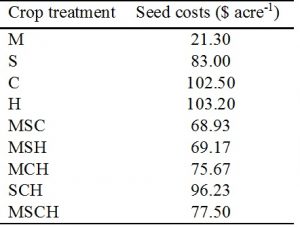 Table 3. Calculated seeding cost per acre. M, pearl millet; S, sorghum sudangrass; C, cowpea; H, sunn hemp.
Table 3. Calculated seeding cost per acre. M, pearl millet; S, sorghum sudangrass; C, cowpea; H, sunn hemp. 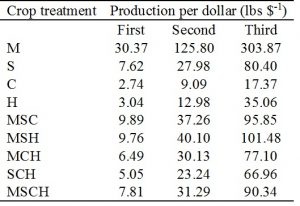 Table 4. Calculated amount of biomass per dollar seed cost for the three harvests (~ 35, 45, and 90 DAP). M, pearl millet; S, sorghum sudangrass; C, cowpea; H, sunn hemp.
Table 4. Calculated amount of biomass per dollar seed cost for the three harvests (~ 35, 45, and 90 DAP). M, pearl millet; S, sorghum sudangrass; C, cowpea; H, sunn hemp.
Farmer Adoption
Although this research did not work directly with farmers, this research provided a foundation for a new project that includes farmer collaborators and on-farm research. Several of these farmers are growing annual forage crops such as sorghum sudangrass and pearl millet, but none have tried sunn hemp or cowpea. This past year during record drought conditions, one farmer Klaas Martens said that he used a contingency plan and decided to grow sorghum sudangrass instead of soybean on some of his fields. The drought-tolerant emergency forage crop produced good yields, while soybean that he planted in other fields did very poorly due to extremely dry weather.
Areas needing additional study
Additional studies are in progress, as well as analysis of the data that this project funded to produce. Work is currently in progress to assess forage quality of the described summer annual forage samples and build a simple ecological model to quantify the effects of changes in competition of the same seeding mixtures used in this research. A new project has begun to work to make cropping systems in the Northeast more resilient for organic farmers. This work includes a comparison of a double-cropped annual system and perennial system each at four different levels of diversity to assess the effects of intra-and interspecific diversity on reducing the overall risk of a cropping system. It will have a research experiment, on-farm trials, and a sociological component that hopes to understand agroecological practices in the organic agriculture movement in New York State.